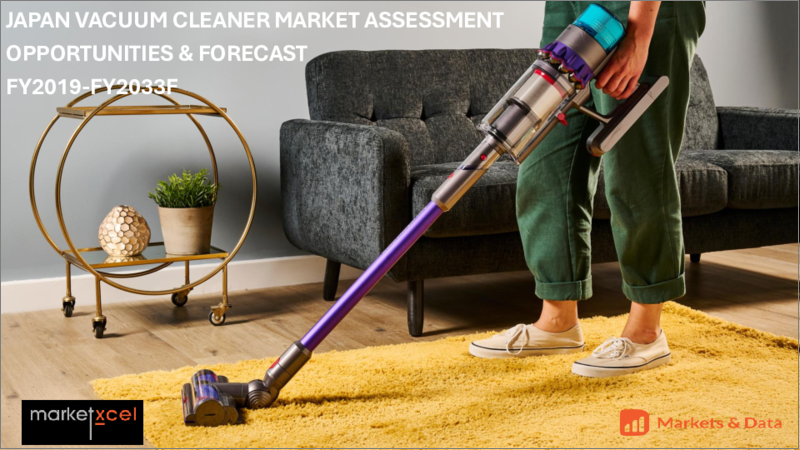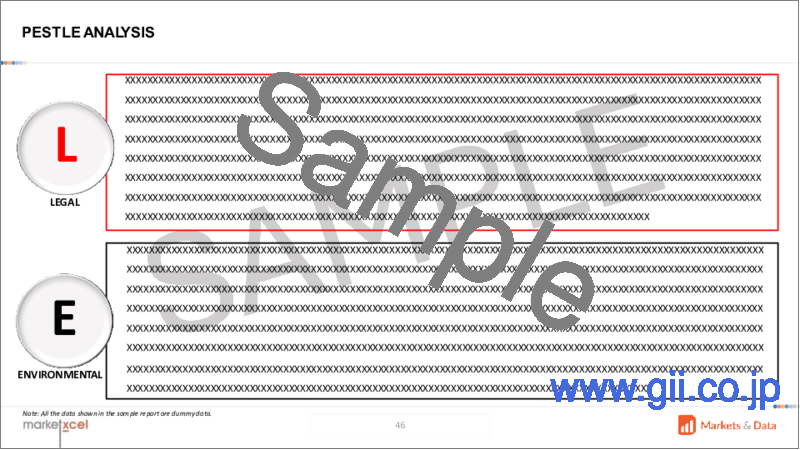|
|
市場調査レポート
商品コード
1705126
日本の掃除機市場の評価:タイプ・電源・用途・流通チャネル・地域別の機会および予測 (2019-2033年)Japan Vacuum Cleaner Market Assessment, By Type, By Power Source, By Application, By Distribution Channel, By Region, Opportunities and Forecast, FY2019-FY2033F |
||||||
カスタマイズ可能
|
|||||||
| 日本の掃除機市場の評価:タイプ・電源・用途・流通チャネル・地域別の機会および予測 (2019-2033年) |
|
出版日: 2025年04月16日
発行: Markets & Data
ページ情報: 英文 145 Pages
納期: 3~5営業日
|
- 全表示
- 概要
- 図表
- 目次
日本の掃除機の市場規模は、2025年の14億4,000万米ドルから、予測期間中はCAGR 7.64%で推移し、2033年には26億米ドルに成長すると予測されています。
日本の掃除機市場の成長を牽引する主な要因には、可処分所得の増加、自動清掃ロボットへの嗜好、スマートホームの増加、コンパクトで機能的な住宅、日本独自の清潔文化が挙げられます。掃除機業界は、イノベーションと進化し続ける消費者ニーズに支えられて、今後も確実に成長すると見込まれています。
特に日本の高齢者層は、この需要の形成に重要な役割を果たしており、自身の身体的な負担に配慮した、高機能で使いやすい掃除機を好む傾向にあります。そのため、利便性や自動化へのニーズに応えるコードレス型やロボット型の掃除機は、今後最も有望な市場セグメントとされています。一方で、キャニスター型掃除機も、畳やフローリングのある広めの住居において、信頼性の高い選択肢として引き続き需要があります。
当レポートでは、日本の掃除機の市場を調査し、市場の定義と概要、市場規模の推移・予測、各種区分別の詳細分析、産業構造、市場成長への影響因子の分析、ケーススタディ、競合情勢、主要企業のプロファイルなどをまとめています。
目次
第1章 プロジェクトの範囲と定義
第2章 調査手法
第3章 エグゼクティブサマリー
第4章 顧客の声
- 回答者の人口統計
- ブランド認知度
- 優先流通チャネル
- 購入頻度
- 購入後に直面する課題
第5章 日本の掃除機市場の展望
- 市場規模の分析・予測
- 市場シェアの分析・予測
- タイプ別
- 電源別
- 用途別
- 流通チャネル別
- 地域別
- 企業シェア分析(上位5社およびその他)
- 市場マップ分析
第6章 需給分析
第7章 輸出入分析
第8章 バリューチェーン分析
第9章 ポーターのファイブフォース分析
第10章 PESTLE分析
第11章 価格分析
第12章 市場力学
- 市場促進要因
- 市場の課題
第13章 市場動向・展開
第14章 ケーススタディ
第15章 競合情勢
- 上位5社の競合マトリックス
- 上位5社のSWOT分析
- 上位10社の情勢
- Hitachi Ltd.
- Panasonic Corporation
- Sharp Corporation
- Toshiba Corporation
- Mitsubishi Electric Corporation
- Makita Corporation
- Tiger Corporation
- Niikura Corporation
- IRIS OHYAMA Inc.
第16章 戦略的提言
第17章 当社について・免責事項
List of Tables
- Table 1. Competition Matrix of Top 5 Market Leaders
- Table 2. Mergers & Acquisitions/ Joint Ventures (If Applicable)
- Table 3. About Us - Regions and Countries Where We Have Executed Client Projects
List of Figures
- Figure 1. Japan Vacuum Cleaner Market, By Value, In USD Billion, FY2019-FY2033F
- Figure 2. Japan Vacuum Cleaner Market, By Volume, In Units, FY2019-FY2033F
- Figure 3. Japan Vacuum Cleaner Market Share (%), By Type, FY2019-FY2033F
- Figure 4. Japan Vacuum Cleaner Market Share (%), By Power Source, FY2019-FY2033F
- Figure 5. Japan Vacuum Cleaner Market Share (%), By Application, FY2019-FY2033F
- Figure 6. Japan Vacuum Cleaner Market Share (%), By Distribution Channel, FY2019-FY2033F
- Figure 7. Japan Vacuum Cleaner Market Share (%), By Region, FY2019-FY2033F
- Figure 8. By Type Map-Market Size (USD Billion) & Growth Rate (%), FY2025
- Figure 9. By Power Source Map-Market Size (USD Billion) & Growth Rate (%), FY2025
- Figure 10. By Application Map-Market Size (USD Billion) & Growth Rate (%), FY2025
- Figure 11. By Distribution Channel Map-Market Size (USD Billion) & Growth Rate (%), FY2025
- Figure 12. By Region Map-Market Size (USD Billion) & Growth Rate (%), FY2025
Japan vacuum cleaner market is projected to witness a CAGR of 7.64% during the forecast period FY2026-FY2033, growing from USD 1.44 billion in FY2025 to USD 2.60 billion in FY2033. Several key factors drive the growth of Japan's vacuum cleaner market, primarily rising disposable incomes, preference for automated cleaning bots, increasing number of smart homes, small and compatible homes, and the cleanliness culture of Japan. The vacuum cleaner industry in Japan is certain to grow, fueled by innovation and ever-evolving consumer needs.
Japan's older generation plays an important role in shaping this demand, favoring advanced and easy-to-use vacuum cleaners that align with their physical capabilities, thus making cordless and robotic segments the most promising options in the near future, catering to demands for convenience and automation, while the canister segment provides a reliable foundation for larger homes with tatami mats and hardwood floors.
Cordless and Robotic Models are the Future
The cordless segment is a major contributor to this growth, prized for its convenience, portability, and ease of use. These vacuum cleaners are often lightweight and convertible into handheld units and appeal to consumers seeking flexibility for quick cleaning tasks. Improved battery life and powerful suction have accelerated their popularity in Japan, where compact living spaces make cordless models a practical choice. Their design eliminates the hassle of cords, aligning with the needs of modern households seeking efficient and space-saving solutions.
The robotic segment is another key driver of growth, offering automation and smart features that resonate with Japan's tech-friendly population. Robotic vacuum cleaners can navigate homes independently, often integrating with digital assistants or apps for remote operations. Their appeal lies in their time-saving capabilities, which is a critical factor in a country with a busy workforce and increasing dual-income households. In Japan, these devices are especially valued for their ability to clean hard-to-reach areas autonomously, thus enhancing their suitability for contemporary living spaces.
While not expanding as rapidly as cordless or robotic models, the canister segment remains a stable force in the market. Canister vacuum cleaners are favored for their powerful suction and versatility, making them ideal for households with carpets or larger areas. Equipped with features like advanced filtration systems, they address health concerns such as allergies, which are significant in Japan's hygiene-conscious culture. Though their growth is slower, canister models continue to hold a substantial share of the market, providing reliability for traditional cleaning needs.
Japan's vacuum cleaner industry is witnessing a surge in preference for cordless and robotic models.
For instance, Hitachi Ltd.'s latest innovation was unveiled in August 2024. The company announced a new cordless vacuum cleaner leveraging augmented reality to gamify cleaning, blending convenience with entertainment. Hitachi enhances qualities with a lightweight design ideal for Japan's compact homes. By integrating AR, Hitachi taps into the demand for efficient, space-saving solutions, making mundane tasks engaging for modern households.
Smart Homes and the Evolution of Vacuum Cleaner Preferences in Japan
Japan, a global leader in technological innovation, has seen a profound integration of smart home systems into everyday life. This trend significantly shapes consumer behavior, particularly in the purchase of household appliances like vacuum cleaners. The rise of smart homes, equipped with interconnected devices that are controllable via apps, voice assistants, and automated systems, has redefined cleaning preferences in Japanese households.
Smart homes in Japan have emphasized convenience, efficiency, and integration with digital ecosystems, thus drawing consumers to appliances that seamlessly connect to these networks. Vacuum cleaners, as essential cleaning tools, are no exception. The ability to control a vacuum cleaner remotely via a smartphone app or integrate it with voice assistants like Amazon Alexa or Google Assistant aligns with the smart home ethos of automation and hands-free operation. This compatibility enhances appeal, as it allows users to schedule cleanings, monitor progress, or start the device from anywhere, fitting the fast-paced lifestyles of Japan's urban population.
Additionally, the compact nature of Japanese living spaces, often apartments with limited storage, makes smart, space-efficient appliances particularly attractive. As smart home adoption grows, it drives demand for vacuum cleaners that enhance this interconnected lifestyle, shifting purchase decisions toward models offering technological sophistication over traditional functionality alone. The features that are most sought after are automation and connectivity, compactness and portability, and health-oriented filtration. These priorities stem from a blend of lifestyle demands that are time scarcity, space constraints and health awareness, and the technological allure of smart homes, which promises efficiency and modernity.
Innovation Pushes Japan's Vacuum Cleaner Market
Japan's vacuum cleaner market is undergoing a transformation driven by cutting-edge technology and shifting consumer demands. The industry is now defined by smart, cordless, and robotic vacuums, with innovative propelling growth beyond initial projections. Companies such as Panasonic and Hitachi are leading this charge, integrating AI, IoT, and sustainability into their latest releases, reshaping not just cleaning habits but the entire home appliance ecosystem. Advancements in automation and robotics have accelerated the shift from manual to automated cleaning.
Japan's focus on hygiene and eco-consciousness has spurred innovations like UV sterilization and biodegradable filters, while the newer models combine mopping, air purification, and voice-guided navigation; the next frontier is object recognition, avoiding obstacles such as pet toys and charging via solar power, such as features are no longer luxuries but expectations.
Japan's vacuum cleaner industry is no longer just about power-cleaning, it's a hub for AI, environmental innovation and demographic-tailored design. With projections for significant market growth, companies that leverage these trends will continue to exceed expectations, turning everyday cleaning into a high-tech, sustainable, and deeply personalized experience.
Future Market Scenario (FY2026-FY2033F)
The vacuum cleaner market will continue to grow due to the rising demand for automated cleaners in Japan.
The market will grow strongly based on the continued expansion of smart homes with an integrated eco-system.
The demand for vacuum cleaners will continue to expand further with the developing priority for portable and easy-to-use devices, convenient for smaller homes.
Key Players Landscape and Outlook
Japan's vacuum cleaner market is thriving, led by major players including Hitachi Ltd. and Panasonic Corporation. Hitachi's cordless vacuum with augmented reality, launched in September 2024, blends innovation with convenience, targeting tech-savvy users. Panasonic drives the market with lightweight, smart-featured vacuums, catering to busy households. Other key Japanese brands, like Sharp and Toshiba, offer advanced cordless and canister models, while Dyson Japan adapts high-end designs for local needs. The future of vacuum cleaners is leading towards growth fueled by demand for automation and compact solutions. Japan's aging population and urban lifestyles make the robotic and cordless vacuums segment quite demanding.
Table of Contents
1. Project Scope and Definitions
2. Research Methodology
3. Executive Summary
4. Voice of Customers
- 4.1. Respondent Demographics
- 4.2. Brand Awareness
- 4.3. Factors Considered in Purchase Decisions
- 4.4. Preferred Distribution Channel
- 4.5. Frequency of Purchase
- 4.6. Challenges Faced Post Purchase
5. Japan Vacuum Cleaner Market Outlook, FY2019-FY2033F
- 5.1. Market Size Analysis & Forecast
- 5.1.1. By Value
- 5.1.2. By Volume
- 5.2. Market Share Analysis & Forecast
- 5.2.1. By Type
- 5.2.1.1. Upright
- 5.2.1.2. Stick
- 5.2.1.3. Drum
- 5.2.1.4. Canister
- 5.2.1.5. Handheld
- 5.2.1.6. Wet and Dry
- 5.2.1.7. Robotic
- 5.2.1.8. Others
- 5.2.2. By Power Source
- 5.2.2.1. Electric
- 5.2.2.2. Battery Powered
- 5.2.2.3. Pneumatic
- 5.2.3. By Application
- 5.2.3.1. Residential
- 5.2.3.2. Commercial
- 5.2.3.3. Industrial
- 5.2.4. By Distribution Channel
- 5.2.4.1. Online
- 5.2.4.2. Offline
- 5.2.5. By Region
- 5.2.5.1. North
- 5.2.5.2. Central
- 5.2.5.3. South
- 5.2.6. By Company Market Share Analysis (Top 5 Companies and Others - By Value, FY2025)
- 5.2.1. By Type
- 5.3. Market Map Analysis, FY2025
- 5.3.1. By Type
- 5.3.2. By Power Source
- 5.3.3. By Application
- 5.3.4. By Distribution Channel
- 5.3.5. By Region
6. Demand Supply Analysis
7. Import and Export Analysis
8. Value Chain Analysis
9. Porter's Five Forces Analysis
10. PESTLE Analysis
11. Pricing Analysis
12. Market Dynamics
- 12.1. Market Drivers
- 12.2. Market Challenges
13. Market Trends and Developments
14. Case Studies
15. Competitive Landscape
- 15.1. Competition Matrix of Top 5 Market Leaders
- 15.2. SWOT Analysis for Top 5 Players
- 15.3. Key Players Landscape for Top 9 Market Players
- 15.3.1. Hitachi Ltd.
- 15.3.1.1. Company Details
- 15.3.1.2. Key Management Personnel
- 15.3.1.3. Key Products Offered
- 15.3.1.4. Key Financials (As Reported)
- 15.3.1.5. Key Market Focus and Geographical Presence
- 15.3.1.6. Recent Developments/Collaborations/Partnerships/Mergers and Acquisition
- 15.3.2. Panasonic Corporation
- 15.3.3. Sharp Corporation
- 15.3.4. Toshiba Corporation
- 15.3.5. Mitsubishi Electric Corporation
- 15.3.6. Makita Corporation
- 15.3.7. Tiger Corporation
- 15.3.8. Niikura Corporation
- 15.3.9. IRIS OHYAMA Inc.
- 15.3.1. Hitachi Ltd.
Companies mentioned above DO NOT hold any order as per market share and can be changed as per information available during research work.






